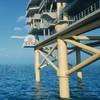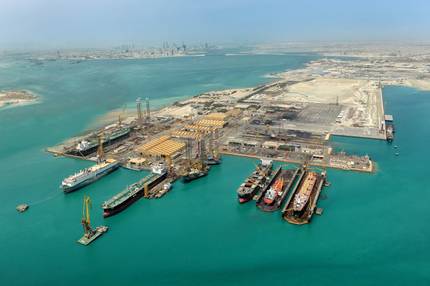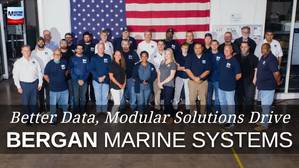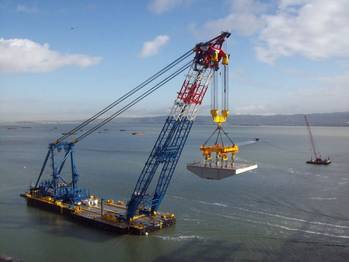An Artistic Interpretation
A marine engineer and self-taught artist, Hsu recently presented a copy of his architectural portrait of Pre Commissioning Unit (PCU) McCampbell (DDG 85) to Secretary of the Navy Richard Danzig. The secretary was one of two principle speakers at McCampell's christening at the Bath Iron Works, Bath, Maine, July 2, 2000.
The newest Arleigh Burke-class guided-missile destroyer is named in honor of CAPT David McCampbell — the Navy's highest-ranking ace with 34 confirmed aerial victories and recipient of the Medal of Honor. McCampbell was awarded the medal after shooting down nine Japanese aircraft while serving as Commander, Air Group 15, USS Essex (CV 9) during the Battle of the Philippine Sea (June 19, 1944) and the Battle of Leyte Gulf (October 24, 1944).
Already a fan of Hsu's art, Secretary Danzig was delighted with the newest drawing. "This is a wonderful tribute to Captain McCampbell and the ship that honors his name." The secretary autographed and inscribed one of Hsu's earlier works — a drawing of PCU Chung Hoon (DDG 93) — and returned it to Hsu. The inscription reads, "with admiration for both your artistic and engineering talent." Another of Hsu's drawings — the christening drawing of the USS Winston S. Churchill (DDG 81) — hangs in the secretary's office.
Combining the discipline of naval engineering with a talent for drawing, Hsu began painting pictures of Aegis ships for the Naval Sea Systems Command (NAVSEA) in 1987. His drawings have become a prominent feature at the christening and commissioning ceremonies for most Aegis cruisers and destroyers.
Captain Fred Parker, NAVSEA's director of destroyer shipbuilding, said, "It's amazing how talented Peter Hsu is because he is a world-class naval architect. He and his drawings have become a big part of the Arleigh Burke commissioning program. He puts a lot of heart into his job — not just his drawings, but his engineering work as well." Ship art is relatively new to America. In fact, it is relatively scarce according to James Cheevers, senior curator at the U.S. Naval Academy Museum. Ship art as an art form was born in the ports of Naples, Malta and Marseilles where wealthy merchants commissioned local artists to paint their merchant and whaling ships on canvas. "There isn't a wealth of naval art compared to merchant and whaling ships," said Cheevers.
The first ship portraits were those that sailors brought back as souvenirs from the China coast. In the 1700's, early American artists earned money by painting portraits and expanded their repertoire to painting pictures of naval battles. When new Navy ships are commissioned, there is no arrangement for ship portraits to be drawn or painted. Although a ship's sponsor may commission a ship's portrait, they more frequently procure silverware or other decorative items to outfit the ship. However, ship-commissioning portraits are becoming more common these days — especially of the new Arleigh Burke destroyers — primarily as a direct result of Hsu's labors.
"I have learned to appreciate the courage of our naval heroes as a result of my research," said Hsu. "Their sacrifice, devotion and bravery move me to be a better person. I also strive to find a way to express what they have done to give meaning and value to freedom and peace — things we too often take for granted — in my art." Hsu studies the biography of the namesake, his photograph and then composes a drawing in naval tradition, facing at a right angle to the ship. In drawing a commissioning portrait, Hsu shifts the focus of the drawing to the ship and its crew. "This is achieved by capturing a special event either during its building phase or at sea trials, which captures the spirit and essence of the ship," Hsu explained.
A full-time marine engineer and a technical director for Anteon, Hsu provides engineering support to the Aegis destroyer program.
With more than 35 years of experience in designing naval combatants, Hsu brings the same technical expertise, creativity and imagination that he applies to the engineering drafting table to his sketch pad. Hsu uses models of ships and airplanes built in his spare time to create a scenario for a ship drawing. The first step might involve building a model plane such as the Hellcat in the McCampbell drawing. Using a DDG ship model Hsu will manipulate the two models of the DDG and the model airplane to find a realistic angle to fit the character of the drawing. He then takes a picture of the namesake and positions it in relation to the two models.
Using a number 5 lead pencil, a common tool in drawing architectural plans, Hsu's drawings are to scale and on an azimuth plot where each angle is carefully plotted from a central point. The outcome is that each of Hsu's strokes defines a direction and a geometric projection, a value more often found in blue prints and architectural drawings than naval art.
Remarkably, Hsu never received any formal art training and has only taken one art class on how to mix oil colors. "As a student I used to pay my rent by working as a waiter on weekends and drawing portraits on a corner in Greenwich Village in New York City," Hsu said. "I drew in high school and found that I made more money working as a waiter, but I had to do both and it worked out. There are a lot of starving artists around that are much better artists than I am. And I am a practical person — that is the engineering side of me — which is why I don't quit my day job."
Hsu painted his first ship when he was four years old. A fourth-generation Chinese-American, Hsu was born in Canton, China after his father became stranded in China at the outbreak of World War II. Hsu was seeing his father off after the war on a troop transit ship bound for the United States when he drew a picture his first ship. "I always liked to draw things, and I quickly sketched a picture of the troop transport ship that took my father across the Pacific to the United States. I was on the boat deck and saw a lifeboat, and was fascinated by it. I started drawing lifeboats along the ship and the captain walked by and saw what I was doing. He looked at the drawing and liked it, so I gave it to him. The captain of the troop transport ship thought my drawing was so good, he kept it.”
"To me, drawing the Arleigh Burke destroyers is a great reward that you cannot put a price on. I am able to give something back to these men who often sacrificed their lives for their country and it is something that I enjoy doing," said Hsu. "It is good for the sailors and it is something that makes a difference for people. In the case of the Oscar Austin christening, the ship's namesake was a 19-year-old Marine who died in Vietnam. "I am glad I can do this and give something back to the family who sacrificed their son for the country."
After the launching of a new Arleigh Burke-class destroyer, Hsu's drawing is presented to the ship's sponsor. At the commissioning the second drawing is given to the ship's crew where it is proudly displayed in the wardroom or crew's mess.
Hsu's drawings frequently touch the emotions of the ship's namesake's family. At the christening of the Donald Cook, Hsu presented a color portrait of Capt. Donald Cook, USMC, to his widow, the ship's sponsor. Present at the same ceremony were two prisoners of war who shared the same confinement cell with the Marine. Cook's wife and the two POWs were emotionally shaken when they saw the painting. "That is exactly how I remember Donald," said one of Cook's fellow prisoners.
Among his varied interests, Hsu is one of the co-founding members of the Marine Forensic Panel of the Society of Naval Architects and Marine Engineers. A naval architect and forensic specialist who spends his professional time working on ship designs and their survivability, Hsu spends his off hours examining ship catastrophes including the sinking of the Titanic, the Lusitania and the Maine. Hsu co-authored a paper, "Titanic and Lusitania — A Final Forensic Analysis," which won the VADM E. L. Chochrane award for best technical paper in 1996. He has investigated the sinking of the USS Maine for the National Geographic Society and presented his findings to the 1997 Naval History Symposium in Annapolis, Md. In 1998, Hsu conducted research and forensic analysis into the photo imagery taken of a Japanese midget submarine attack on the USS West Virginia (BB 48) on December 7, 1941, and the underwater shock explosion phenomena, concussion wave propagation and cavitation effects seen in the attack photo-imagery. He co-authored an article, "Pearl Harbor — Attack From Below," which appeared in the December 1999 issue of Naval History. Hsu and his co-authors assert that two U.S. battleships may well have been damaged during the Pearl Harbor attack by a two-man Japanese midget submarine. The Naval Institute recognized Hsu and his co-authors with its "Author of the Year Award" for the article in April 2000.
Hsu is currently working on the commissioning and christening portraits of Churchill (DDG 81), Lassen (DDG 82) and Mason (DDG 87). Also, in remembrance of the 17 Sailors who perished during an October terrorist attack, Hsu is busy drawing the USS Cole (DDG 67).
The preceding article was originally published in the January/February 2001 edition of Surface Warfare, Vol. 26, No. 1, and reprinted with permission.











